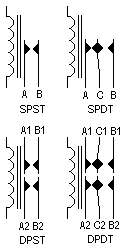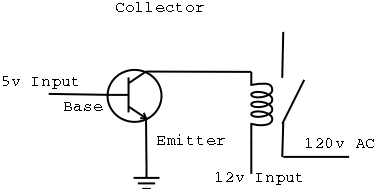Relays
Introduction
A relay is an electrical switch that opens and closes under control of another electrical circuit. In the original form, the switch is operated by an electromagnet to open or close one or many sets of contacts. It was invented by Joseph Henry in 1835. Because a relay is able to control an output circuit of higher power than the input circuit, it can be considered, in a broad sense, to be a form of electrical amplifier.
A relay has two components. One is the controlling the part and the other the contolled part. The controlling part is a coil which creates a magnetic field. This coil requires a low voltage (around 5-12V) and a low current (around 50mA) (The actual ratings are given on the relay). The controlling coil has two terminals. Generally there is no polarity for the controlling coil, but on some relays there might be polarity for which you have to be careful. Due to the field generated by this coil, the controlled part which is made up of magnetic material is activated (by attraction to this magnetic field). The controlled circuit generally has a high voltage and current rating (which is again given on the relay).
Types
Since relays are switches, the terminology applied to switches is also applied to relays. According to this classification, relays can be of the following types:

- SPST (Single Pole Single Throw)
- These are like a simple switches. They have two terminals which can be switched on/off. In total, four terminals when the coil is also included.
- SPDT (Single Pole Double Throw)
- These have one row of three terminals. One terminal (common) switches between the other two poles. It is the same as a two-way switch. In total, five terminals when the coil is also included.
- DPST (Double Pole Single Throw)
- These have two pairs of terminals. Equivalent to two SPST switches or relays actuated by a single coil. In total, six terminals when the coil is also included.
- DPDT Double Pole Double Throw)
- These have two rows of change-over terminals. Equivalent to two SPDT switches or relays actuated by a single coil. In total, eight terminals when the coil is also included.
In Double Throw relays (Single Pole or Double Pole), there are two poles (A,B in figure). The common terminal (C) of the relay by default (when relay is not powered) is connected to one of these terminals (A). This is called Normally-Connected pole. The other pole (B) is called Normally-Open pole. You can always use a Double Throw relay as a Single Throw relay. Just don't connect one of the A or B.
Applications
Relays are used:
- to control a high-voltage circuit with a low-voltage signal
- to control a high-current circuit with a low-current signal, like running a motor from a logic circuit
- to isolate the controlling circuit from the controlled circuit when the two are at different potentials, for example when controlling a mains-powered device from a low-voltage switch
How to Use

Controlling a relay using a transistor
- Decide which type of relay your application requires. If you just want to turn on and off something, then SPST is enough. If you want to switch two different circuits on/off using the same relay, use a DPST. If you want two-way switching, use a SPDT or DPDT depending on whether you want to use the relay for one or two circuits respectively.
- For a Double Throw relay, decide the logic you want to implement. Which circuit do you want to remain on normally and which should turn on then you turn the relay on (pass current through the controlling coil).
- For powering the controlling coil, you will not be able to take the output from a normal IC since they give out very less current (around 10mA at max). For this you will need either a transistor or a buffer which can supply the required current. Or else you can try and get relays which require low current for switching.
Example

Driving a motor through a relay
A method of using a relay to drive a motor is shown. It uses a SPST relay. When pt. A is given logic high, the relay switches on and current flows through the motor and it runs. This is an application of using relay to drive a high current circuit from a low-current signal. Although the control signal is low-current, you still need a transistor or a buffer to drive the relay coil, or else get a relay with low driving current.